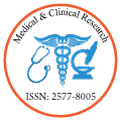Remarkable pain control and functional improvement in clubfeet-related ankle osteoarthritis post autologous expanded mesenchymal stem cell therapy
Author(s):
Hassan Mubark*
Ankle joint osteoarthritis (OA) is not as common as knee and hip OA but it causes a significant socioeconomic burden in society. The causes of ankle OA could be primary or secondary to previous ankle trauma, inflammatory arthritis like rheumatoid arthritis, avascular necrosis, post-infectious, clubfoot, and other rare causes. Ankle OA is hard to treat conservatively. Limited options, including physiotherapy, supportive custom-made braces, weight reduction, and anti-inflammatory medicines. Standard surgical options are joint arthrodesis and ankle replacement. Arthrodesis can limit the movement of talar and subtalar joints, making it difficult to be accepted by athletes who require functional joint movement. Ankle replacement might last between five and ten years and is sometimes technically challenging. Herein we report a case of a seventy-one-year-old male property investor. His past medical history of bilateral congenital clubfeet with the left foot more affected and pointed backward required three surgeries at the age of two through five to align the foot in the correct direction, and his left ankle was fused. In his mid-forties, he had mild ankles discomfort which was managed by suitable orthotics, despite the ankle pathology he enjoys various recreational physical sports at a premium competitive level with determination. At the age of sixty-seven, his symptoms increased gradually. He was diagnosed with severe secondary severe subtalar and mild talar OA, confirmed by X-rays; by the age of seventy-one, he had significant pain and loss of ankle function to the extent he could hardly walk five steps or play any sport. He failed conservative management with various supportive orthotics and long-term anti-inflammatory medicines. He elected experimental autologous fat-derived expanded mesenchymal stem cells (MSCs) combined with platelet-rich plasma (PRP). After two doses nine months apart, he responded superbly to become pain-free. Three months after the second dose, he was able to walk normally, play sports, and intend to return to competitive table tennis, but we recommended continuing using supportive orthotics. We predict MSCs slow the progression of OA. We believe this is the future medicine to try efficiently and safely regardless of the number of booster doses given.



